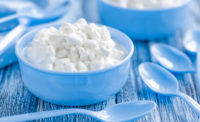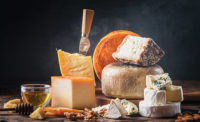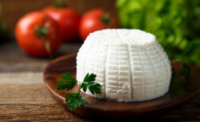Enzymes and cultures are critical for helping to ensure dairy products have the most advantageous flavor and appearance while staying fresher longer. And demand for these ingredients is ballooning.
The global market for dairy enzymes will more than double by 2031 to approximately $1.5 billion, with about an 8% compound annual growth rate (CAGR), forecasts Fact.MR, a Dubai-based market research and consulting firm. The North American dairy enzyme market will have a 7% percent CAGR through 2031, Fact.MR forecasts.
Dairy producers typically use enzymes as coagulants in cheese production or as a bio-protector for enhancing product safety and freshness, states Santosh Kumar, Fact.MR senior consultant — food and beverages, in a November 2021 report on the dairy enzymes sector. Processors also are leveraging enzymes to support the production of lactose-free dairy products because of increasing consumer awareness of digestive health, he states.
In addition, developers are seeking to create enzymes that reduce whey bitterness and facilitate trouble-free ultra-high temperature processing, Kumar says.
“As dairy product manufacturers look to achieve production sustainability, investments in high-grade enzymes, both plant, and animal sourced, is increasing, which are aimed at increasing shelf life of finished products,” he adds.
Interest also is growing for dairy starter cultures, which are microorganisms that processors add to products to create specific outcomes such as the starting of fermentation and changing the chemical composition and physical properties of a substrate to get a more homogenous item, particularly for yogurt and cheese. Developers also use starter cultures to produce lactic acid from lactose to assist in the coagulation of milk protein and influence the flavor and texture of cultured and/or aged products, reports Ithaca, N.Y.-based Cornell University’s Milk Quality Improvement Program (MQIP).

“The type of starter culture used depends on the desired product,” MQIP states. “Suppliers have a variety of cultures that can be tailored to an operation. Varying the incubation temperature of certain cultures can influence the flavor profile and other attributes of the final product.”
The dairy global starter culture market is forecast to have a CAGR of 4.5% percent from 2021 to 2027 to $1.67 billion, according to The Insight Partners, a Pune, India-based market research and consulting firm.
Keep track of the trends
The popularity of specific enzymes, meanwhile, varies in accordance with food industry trends, says Christina S. Barsa, director, strategic accounts for New York-based Enzyme Development Corp.
“The lactose-free milk market continues to grow, expanding the sale of lactase,” she states. “New innovations in manufacturing have opened the door for highly purified and easily filterable lactase.”
Growing consumer interest in wellness also is making lactase enzymes more popular.
The enzyme modified cheese sector is expanding as well and resulting in new flavor profiles, while operators also are adapting old formulas to have cleaner product labels, Barsa says. She notes, for instance, that more producers are using protease instead of phosphates. Expanding dairy sector interest in non-GMO and gluten-free products is creating demand for additional enzymes.
“Processors can use a variety of lipases for these applications in addition to botanical proteases such as ficin from the fig tree, a protease from the thistle flower, and microbial enzymes,” she says.
Growing consumer interest in wellness also is making lactase enzymes more popular, says Ronald Heddleson, a food scientist in the technical service group at Novozymes North America Inc., a Franklinton, N.C.-based enzyme supplier.
“Health-conscious consumers interested in ‘free from’ foods are turning to lactose-free dairy for lifestyle reasons, and dairy producers are using lactase enzymes as a means to deliver the sugar reduction that consumers are seeking in formulated dairy products like flavored milk and yogurt,” he notes. “We’re also seeing lactose-free claims expanding beyond milk to other dairy categories like ice cream.”

Clean-label enzymatic solutions that improve texture in yogurt and other cultured dairy products are becoming more prevalent as well, Heddleson says.
“Enzymes are used to either reduce thickness, especially in products with high protein, or to thicken, especially in products with lower fat content,” he states.
Indeed, more operators are seeking enzymes that modulate a product’s texture and appearance, says Collette Lentz, global business product line leader, fresh dairy enzymes and probiotics for International Flavors & Fragrances Inc. (IFF), a New York-based enzyme provider. Proteolytic enzymes, or proteases, for instance, which break down proteins, can modulate the texture of high-protein dairy and dairy-alternative products, she notes.
Cultures for yogurts that deliver an optimal and stable freshness and a premium texture that last beyond a product’s listed shelf life also are in demand, adds Charlotte Debare, IFF business product line leader, fresh dairy cultures. They are critical for reducing waste while allowing producers to extend their geographic reach.
Selecting the optimal combinations of enzymes and cultures to create desirable product flavors starts as a trial-and-error process, Barsa says, noting that it can be challenging to optimize the enzyme dosage to reduce production time and enhance output without changing the overall flavor profile.
“In some cases, this may involve reducing a protease dosage to cut down on any bitterness that may develop through the protein hydrolysis in a dairy flavor and increasing the peptidase dosage to speed up the reaction that would remove the bitterness,” she states.
Determining the necessary attributes of the final product is an important way to pinpoint the proper enzymes and cultures to incorporate, says Brian Schlatter, business development, Northeast representative for Fromagex Inc., a Rimouski, Quebec-based distributor of cheesemaking solutions.
“Think of this as designing a piece of furniture,” he states. “One starts with what it is going to look like and then works backwards, designing each piece that makes up the whole. This defines what can or cannot be used.”
It is critical as well for dairy producers to analyze market needs before deciding which enzymes to incorporate in their products, Lentz states.
“Choosing the optimal enzyme begins with defining the end goal and target function of the enzyme,” she notes. “Once this is defined, the processing conditions such as pH and temperature are imperative to understand in order to pick the enzyme that will have the best performance under these conditions.”
A dairy manufacturer, for instance, might seek an enzyme solution to help reduce thickness in a new high-protein yogurt, Lentz says.
“In this case, a protease enzyme that also performs well under fermentation conditions will allow the manufacturer to reach their desired viscosity reduction targets,” she notes.
A host of considerations
Maintaining product functionality while differentiating selections also should be key objectives when leveraging enzyme and cultures.
Functionality, cost, and process efficiency also will dictate the proper enzymes to incorporate into dairy products, Heddleson states.
“The enzyme should be useable at temperatures, pH conditions, and in food formulation matrices that enable its activity while minimizing any negative impact on finished food product quality,” he notes.
Indeed, enzymes and cultures that net manufacturing cost savings while meeting consumer needs are become increasingly popular, says Erika Gayhart, associate marketing manager, food cultures and enzymes for Chr. Hansen Inc., a Milwaukee-based provider of enzymes and cultures.
“Processors must first identify what they are looking to change or approve to determine the optimal enzymes to incorporate in their dairy products, she states. “The right cultures and enzymes can improve productivity, aid in cost savings, optimize moisture content, increase speed, and more. The important thing is that processors are getting value from the solutions they use.”

Some cultures, for instance, allow yogurt producers to reduce costs by lessening the need for added protein or stabilizers, while other cultures and enzymes can enable cheese producers to improve slicing and eliminate the need for paper dividers, she states.
Maintaining product functionality while differentiating selections also should be key objectives when leveraging enzyme and cultures, says Adrian Gauna, technical and sales export manager of Sacco System, a Cadorago, Italy-based producer of enzymes and starter cultures and partner of Miami, Fla.-based enzymes and cultures distributor Amerilac Corp. He notes, for instance, that cultures with a protective effect are becoming more prevalent.
However, it still might be tricky to seamlessly incorporate enzymes into products because of the necessary incubation period to allow the enzyme to act, which can lengthen process flow and manufacturing time, Heddleson states.
“There may be occasions when the enzyme needs to be inactivated by denaturation, requiring an additional thermal process step, which may add to total processing time,” he notes. “Technical service experts at enzyme suppliers can assist in suggesting the optimal dosage ranges, environmental and process conditions, and the steps to improve efficiency and minimize the impact of thermal processing steps when enzyme inactivation is needed within the finished product,” Heddleson says.
Processors also should request product application guidance sheets from enzyme suppliers to better manage the wide variety of product applications and formulations, he states, noting that suppliers “can be your partner for testing and supporting any troubleshooting needed in the least amount of time.”
In addition, it is key for producers to work with suppliers that can help define the best solutions for specific production conditions, Debare says.
“Processors can best meet challenges or pursue opportunities by having an open and honest dialogue with their suppliers,” Gayhart adds. “Having that conversation and defining expectations to tackle challenges is important for transparency and better service throughout the process.”



